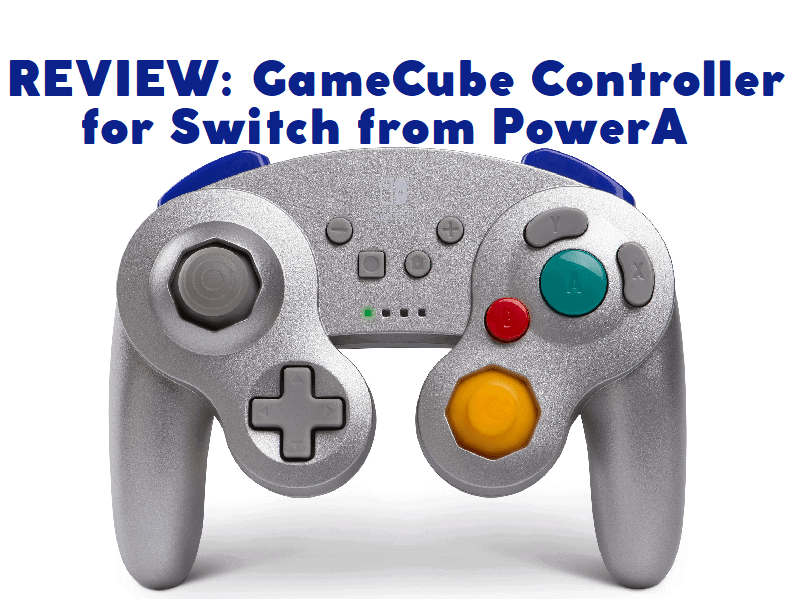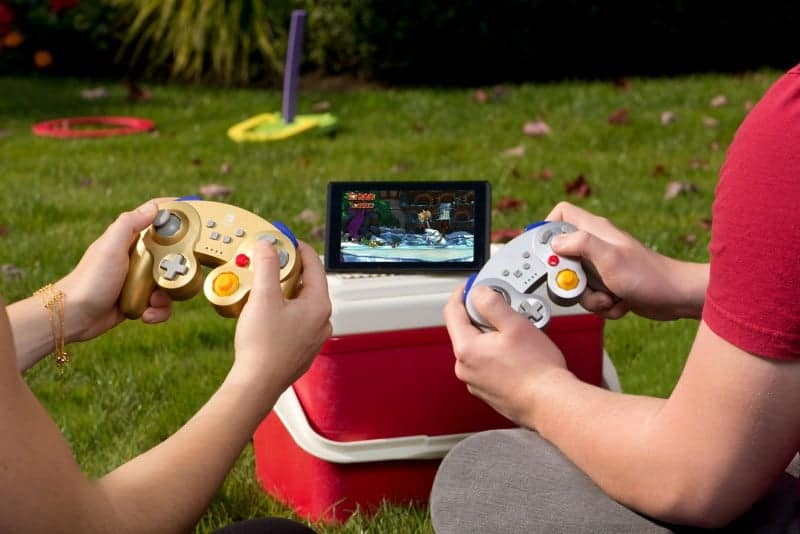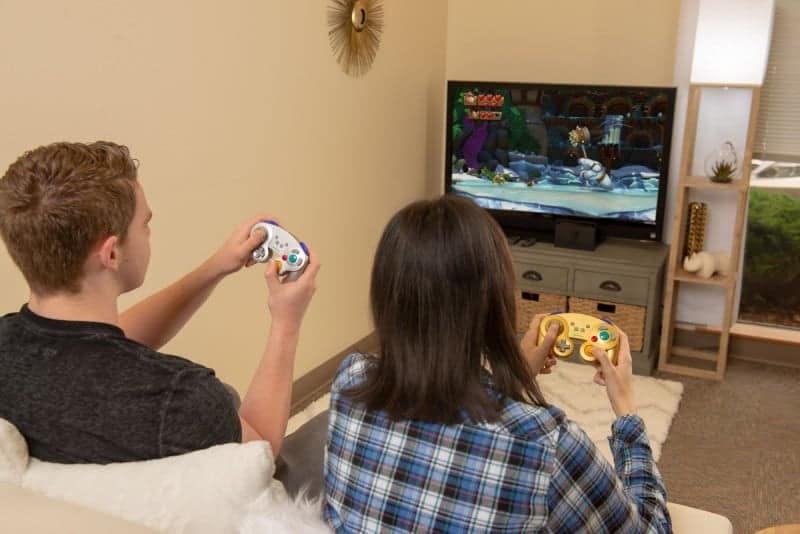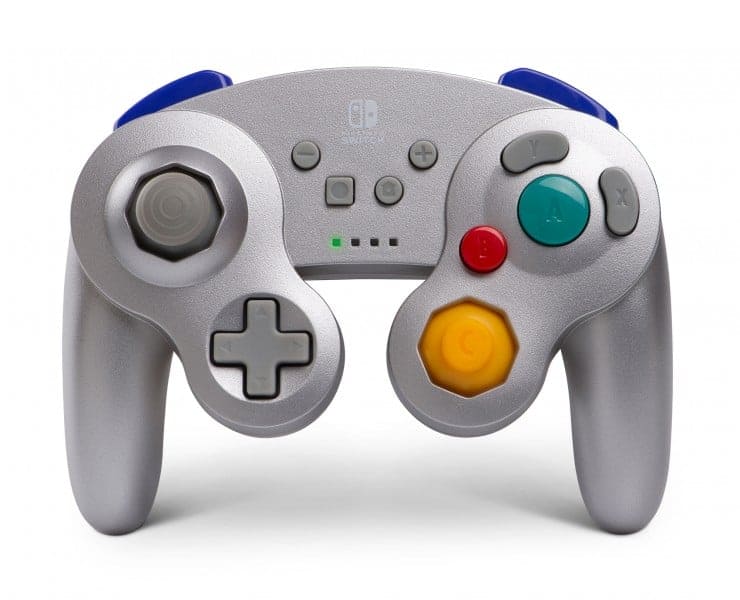With Smash Bros. Ultimate being out, we reached out to the folks over at PowerA to see if they could spare some controllers for us to review. We wanted to give our readers a fair chance to find out about these third party controllers that are out now from PowerA. This review is over the Gamecube controller from them, and soon there will also be a review for their Enhanced Wireless Controller. Stay tuned for that as well. So let’s just right into the pros and cons of this and see what I really think of this Gamecube style controller ($49.99, PowerA).!
Features:
•’ The preferred gamepad for Super Smash Bros Ultimate
• Classic GameCube design plus larger D-pad and added left shoulder button
• System buttons added for compatibility with all Nintendo Switch Games*
• Officially licensed product with 2-year limited warranty
• Bluetooth Wireless Freedom
• Integrated motion controls
• LEDs for power, player number and low battery warning
• Includes two AA batteries for up to 30 hours of gameplay’
Description:
‘GameCube controllers are widely considered the best way to play Super Smash Bros Ultimate. Pull off precise attacks with octagonal gated sticks, larger A button and nostalgic feel of these officially licensed wireless and wired controllers for Nintendo Switch, from PowerA.’
Unboxing:
Pros:
First off, we can kick this thing off by saying that the amount of color options that exist for this controller are aplenty! The original GameCube controllers were also in multiples. So it goes without saying that I’m glad that PowerA didn’t just skimp and stick with one color.
Now, enough fanboying. I have to also talk about some of the great functions and improvements this thing brings to the table. First, let’s start by taking a look around the controller. The first thing that anyone who has ever held an original GameCube controller will notice is the inclusion of an extra “Z” button. On the original, there was only one and it was a shoulder button. Now, there are two of them and they’re assigned as L and R respectively.
You may also notice that they’ve improved the D-Pad by making it larger. Not terribly large, of course. It feels like what Nintendo should’ve done in the first place. I’m not entirely certain as to what they were thinking, but this version of the D-Pad is a perfect size. The D-Pad also seems to have a matte rubber with a textured surface to help your thumb out. I’m not entirely certain that GameCube controllers used to have that and mine just rubbed off. But if it’s PowerA’s idea, then it’s a superb choice.
On the front, you now have plus, minus, Home, and screenshot buttons. To me, this is a sigh of relief. As some controller companies just include button combinations for screenshot for instance. With regards to the Home button, with the press of it, you can actually turn on the Switch, unlike some third-party controllers. On the top of the controller, there is a sync button. This button is clearly hidden out of the way so that you don’t accidentally press it. There is also the inclusion of four LED indicators so you know which player you are.
The next good thing about this, well to me anyway, is that AA batteries are supported (some of you may say required). If you hate AA’s that must mean you have single-use batteries. Rechargables make this pretty much the same as having a controller with a rechargeable battery. I prefer this because I hate cords strewn about for charging controllers. But anyway, I digress. Having batteries of any kind are great because that makes them completely wireless. And that is a win for us as gamers.
Every button, including the shoulder buttons press, feel, click, and sound the way that GameCube buttons should. They updated the thumbsticks to click in as well for any game that may require it. The controller has motion control support built into it the way that Nintendo’s first-party controllers do.
Now that we’ve talked about differences between the original GameCube controller and this one from PowerA, we can now talk about how they’re the same. I was looking over this thing and comparing it to the original model and I’m happy to report that it is almost 1 for 1 to the original. Not to mention I was going crazy over the absolutely flawless build quality. This thing feels precisely the same as the original too. The weight is a harder thing to judge since the Nintendo version had a cord that added some weight at the top. There is the battery weight involved though, so as far as I could tell, they’re about the same.
Best of all, the battery life is so long that I gave up testing it. I couldn’t find an exact way to test it without playing it. PowerA does state that it’s an estimated 30 hours. So assuming that that’s true, you’ll get your money’s worth out of the batteries you put in it. Speaking of batteries though, the battery section barely makes the controller much larger than the original GameCube controller. Smash Bros. Ultimate recognizes it as a GameCube controller as well. This makes it easier for mapping the controller to your liking, but also it should already have the layout from Smash Bros. Melee from the get-go.
Last major point about this is Bluetooth makes this most likely compatible with PC games/emulators and unfortunately, I was unable to test it. Although a quick Google search says that it is indeed possible. If you’re reading this, end up buying one of these and can test it, let us know the results down in the comments section.
Cons:
This will most likely be the smallest cons section of anything that I’ve ever personally reviewed for Hackinformer. To me, the omission of the Amiibo/NFC support is not necessarily a huge ordeal. But I would love to see the inclusion of it in a future revision for the price point that this is. No rumble could possibly be an issue to some of my readers out there. Again, this is a non-issue for me as I see rumble or vibration as something of a battery waster. However, I know there are some out there that feel that it creates a sense of immersion for the game.
And now, let’s come back to the topic of the controller requiring batteries. I know that to me needing batteries was great because it means this thing is truly wireless. But maybe to some of you, this is a con. If it is, I have to bring up the fact that maybe PowerA could include a version that has a built-in rechargeable battery. It would certainly be cool that if it could charge as you played as well. Thus just looking like a wired version of the controller during those times. And that’s it for the cons! I couldn’t find anything that I disliked about this thing and I really tried, you guys.
Overall Thoughts:
To me, this controller beats any other third party controllers that I’ve tested up to this point. Hands down, it is as good of an update as the GameCube controller has ever received. If you hadn’t told me Nintendo didn’t make it, I would’ve thought that it was a first party accessory. The weight of it feels great and the buttons all feel the way that my hands and muscle memory tell me they should feel.
There really is no other controller you should be spending your money on. If you want to save some money, I supposed you could buy the wired version of this. But I’m not entirely certain the quality of that one as I haven’t been able to review it personally. This is a perfect solution for Smash Bros. Ultimate, but it really feels great for every other game I’ve played on the Switch. I tested Mario Tennis Aces, Mario Kart 8 Deluxe, and Mutant Mudds Collection. This controller makes all of those feel like they’re just GameCube games and that is a beautiful thing.
If you’d like to buy one of these ASAP, click here.
If you like the author’s work, follow him on Twitter @V1RACY and don’t forget to enter the weekly giveaways!
And as always, stay tuned here on Hackinformer.com for so much more and follow us on Twitter @Hackinformer







